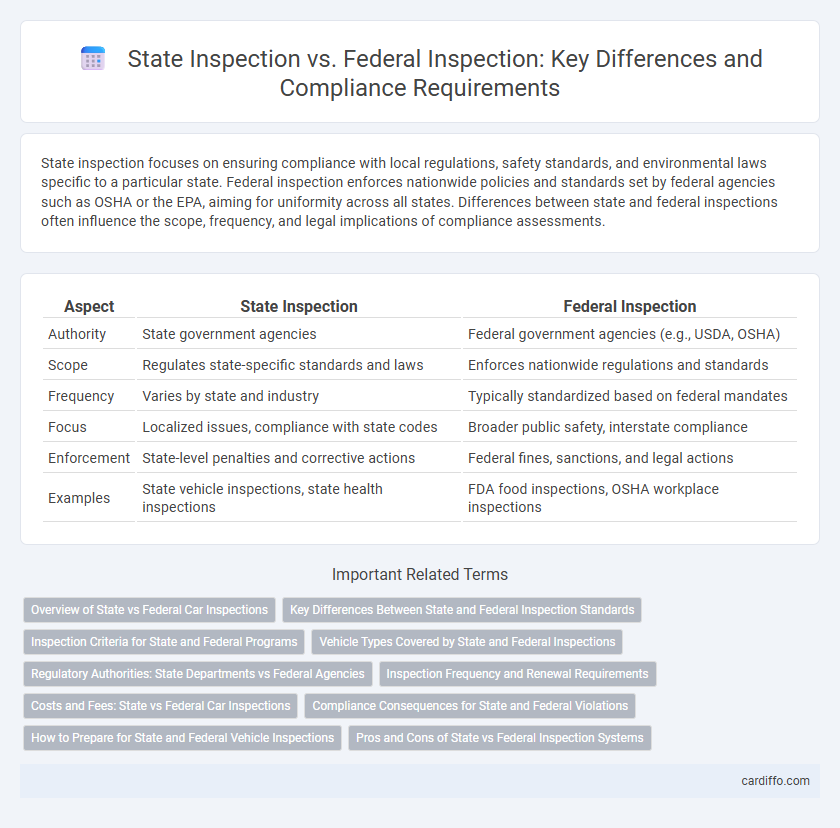State inspection focuses on ensuring compliance with local regulations, safety standards, and environmental laws specific to a particular state. Federal inspection enforces nationwide policies and standards set by federal agencies such as OSHA or the EPA, aiming for uniformity across all states. Differences between state and federal inspections often influence the scope, frequency, and legal implications of compliance assessments.
Table of Comparison
| Aspect | State Inspection | Federal Inspection |
|---|---|---|
| Authority | State government agencies | Federal government agencies (e.g., USDA, OSHA) |
| Scope | Regulates state-specific standards and laws | Enforces nationwide regulations and standards |
| Frequency | Varies by state and industry | Typically standardized based on federal mandates |
| Focus | Localized issues, compliance with state codes | Broader public safety, interstate compliance |
| Enforcement | State-level penalties and corrective actions | Federal fines, sanctions, and legal actions |
| Examples | State vehicle inspections, state health inspections | FDA food inspections, OSHA workplace inspections |
Overview of State vs Federal Car Inspections
State car inspections primarily address safety and emissions standards specific to regional regulations, ensuring vehicles comply with local laws. Federal inspections, often linked to nationwide programs, emphasize uniform safety requirements and environmental mandates that apply across all states. Differences in inspection frequency, criteria, and enforcement reflect the distinct roles and jurisdictions of state versus federal authorities in vehicle oversight.
Key Differences Between State and Federal Inspection Standards
State inspection standards vary by region, often focusing on compliance with local laws, safety regulations, and environmental codes specific to that state. Federal inspections enforce nationwide regulations established by agencies like OSHA or FDA, ensuring uniformity in health, safety, and operational practices across all states. Key differences include the scope of authority, regulatory emphasis, and inspection frequency, with federal inspections typically having broader jurisdiction and stricter penalties.
Inspection Criteria for State and Federal Programs
State inspection criteria often emphasize compliance with local regulations and standards tailored to regional needs, reflecting specific public health and safety concerns. Federal inspection programs enforce uniform standards set by agencies such as the FDA or OSHA, ensuring nationwide consistency in areas like food safety, environmental protection, and workplace conditions. Differences in inspection criteria between state and federal programs can affect the scope, frequency, and methods used during inspections, impacting overall regulatory enforcement.
Vehicle Types Covered by State and Federal Inspections
State inspections typically cover passenger vehicles, motorcycles, and light trucks to ensure compliance with local safety and emission standards, while federal inspections often focus on commercial vehicles, buses, and heavy-duty trucks operating interstate. Federal inspections enforce regulations set by agencies like the Federal Motor Carrier Safety Administration (FMCSA), ensuring that larger vehicle types meet national safety and environmental requirements. Differences in vehicle types covered reflect the varying scopes and regulatory objectives of state versus federal inspection programs.
Regulatory Authorities: State Departments vs Federal Agencies
State inspections are conducted by State Departments of Agriculture or Health, focusing on compliance with local regulations and standards tailored to specific state requirements. Federal inspections are overseen by agencies such as the USDA or FDA, enforcing nationwide laws and regulations to ensure uniform safety, quality, and labeling standards. State Departments often collaborate with federal agencies to align inspection protocols and share data for comprehensive regulatory oversight.
Inspection Frequency and Renewal Requirements
State inspections typically occur annually or biennially, with renewal requirements varying by state regulations and vehicle type. Federal inspections, particularly for commercial vehicles, are mandated at regular intervals defined by the Federal Motor Carrier Safety Administration (FMCSA), often requiring more stringent and frequent checks. Compliance with state inspections ensures local road safety standards, while federal inspections maintain nationwide consistency in vehicle operation and safety.
Costs and Fees: State vs Federal Car Inspections
State car inspections typically involve lower fees compared to federal inspections, with costs varying significantly by state regulations and inspection requirements. Federal inspections often encompass more comprehensive safety and emissions testing, contributing to higher overall expenses for vehicle owners. Understanding specific state versus federal fee structures is crucial for budgeting and ensuring compliance with all mandatory vehicle inspection standards.
Compliance Consequences for State and Federal Violations
Violations of state inspection regulations typically result in fines, license suspension, or mandatory corrective actions that vary based on jurisdictional standards and the severity of non-compliance. Federal inspection violations, governed by agencies such as OSHA or EPA, often incur higher penalties including substantial fines, legal enforcement actions, and potential criminal charges for significant breaches. Compliance with both state and federal inspection requirements is critical to avoid operational disruptions, legal liabilities, and reputational damage.
How to Prepare for State and Federal Vehicle Inspections
Preparing for state and federal vehicle inspections requires understanding specific regulatory requirements set by respective authorities. Ensure compliance by checking emission standards, safety features like brakes and lights, and documentation such as registration and insurance. Conduct pre-inspection maintenance, including tire pressure, fluid levels, and windshield condition, to meet criteria for both state Department of Motor Vehicles and federal Environmental Protection Agency inspections.
Pros and Cons of State vs Federal Inspection Systems
State inspection systems offer localized oversight with better adaptability to regional regulations and quicker response times, but they may lack uniformity and consistency across different states. Federal inspection systems ensure standardized procedures and nationwide compliance, enhancing overall safety and fairness, although they can be slower and less flexible due to bureaucratic layers. Balancing the benefits of tailored state approaches against the consistency of federal oversight remains a critical consideration in optimizing inspection frameworks.
State inspection vs federal inspection Infographic

 cardiffo.com
cardiffo.com